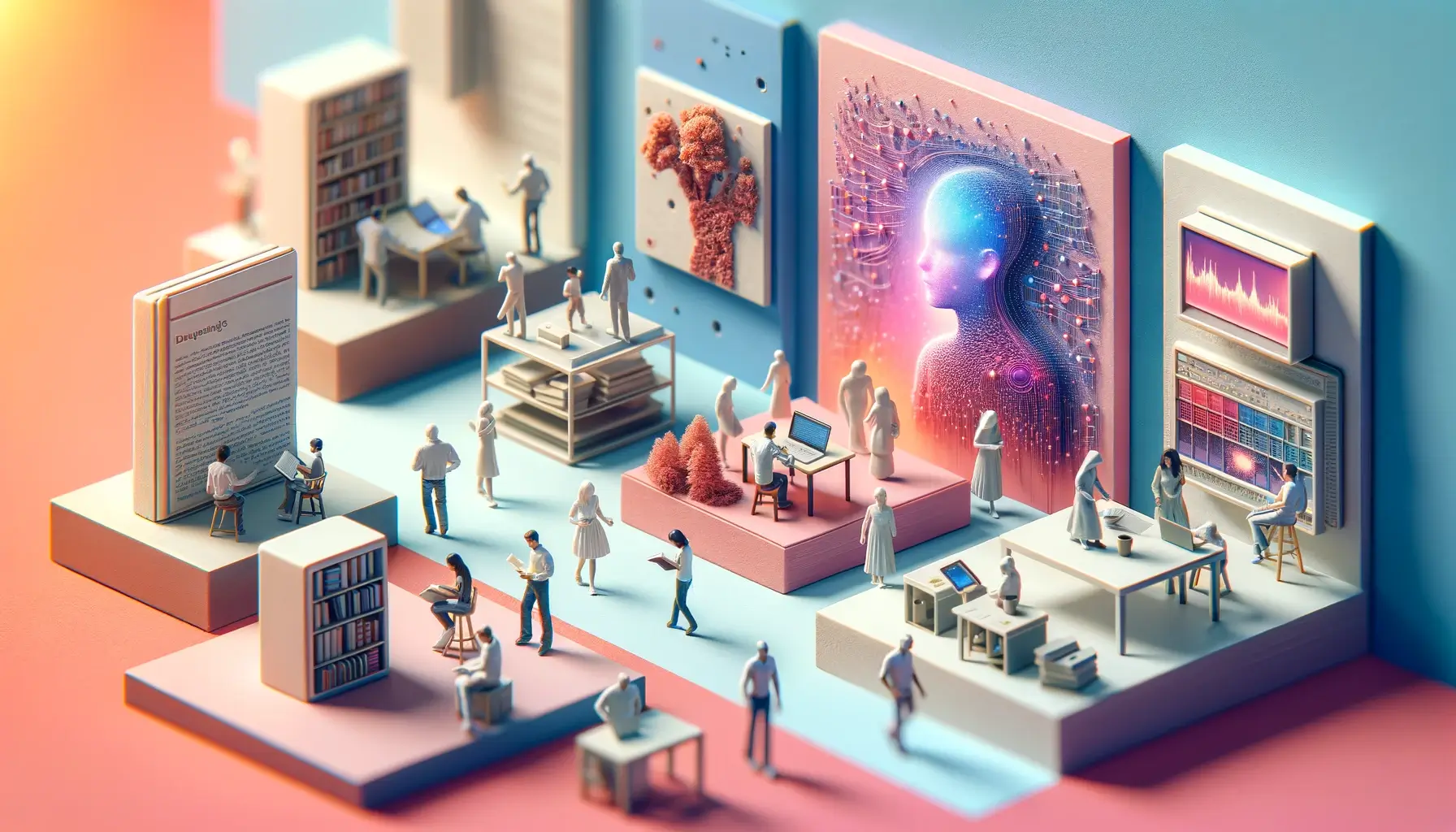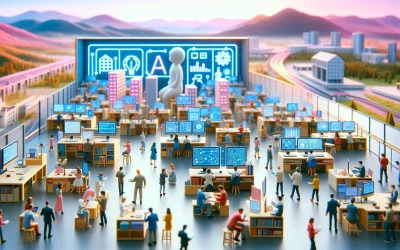Generative AI is a subset of artificial intelligence that has been gaining popularity in recent years. It involves a machine learning model that is capable of generating new data that looks like the data it was trained on. The technology learns the patterns and structure of the input training data and then generates new data that has similar characteristics.
Generative AI is capable of creating content from various types of data, such as text, images, audio, and even software code. It has the potential to revolutionize the way we create content, as it can produce high-quality text, graphics, and videos in a matter of seconds. The recent buzz around generative AI has been driven by the simplicity of new user interfaces for creating such content.
Despite its potential benefits, generative AI also raises concerns about its potential dangers. Some worry that it could be used to create fake news or other types of disinformation. Others are concerned about the ethical implications of using AI to generate content without human oversight. As generative AI continues to evolve, it will be important to consider both its potential benefits and its potential risks.
Defining Generative AI
Generative AI is a type of artificial intelligence that is capable of generating new data, such as images, text, videos, and other media in response to inputted prompts. This is in contrast to discriminative AI, which is designed to classify inputs into predefined categories. Generative AI is able to create new data by learning the underlying patterns and structure of the input training data.
Generative AI has many applications, including in the fields of art, design, and entertainment. For example, it can be used to generate new images, music, and videos that are indistinguishable from those created by humans. It can also be used to create chatbots that are able to generate realistic responses to user input.
One of the most popular examples of generative AI is DALL-E, a program developed by OpenAI that is capable of generating images from textual descriptions. For example, if a user inputs the prompt “a bird made of fire,” DALL-E is able to generate an image of a bird that is made of flames. Another example is ChatGPT, a chatbot that is able to generate human-like responses to user input.
History of Generative AI
Generative AI is not a new concept. The idea of generating new content using machine learning algorithms has been around since the 1960s. One of the earliest examples of generative AI is ELIZA, a chatbot developed by Joseph Weizenbaum in 1966. ELIZA was designed to simulate a conversation with a therapist and was based on a simple rule-based system.
In the 1990s, researchers began to explore the use of neural networks for generative tasks. One of the earliest examples of this was the use of recurrent neural networks (RNNs) for language modeling. RNNs are a type of neural network that can process sequential data, making them well-suited for tasks such as language modeling.
In recent years, generative AI has seen a surge in popularity due to advancements in deep learning and natural language processing (NLP). One of the most popular generative AI models is the GPT (Generative Pre-trained Transformer) series developed by OpenAI. These models use a combination of deep learning and NLP techniques to generate high-quality text, images, and other types of data.
How Generative AI Works
Generative AI is a type of artificial intelligence that uses machine learning models to generate new and original content. It is capable of producing a wide range of outputs, including text, images, videos, and other types of media.
Machine Learning Models
Generative AI relies on machine learning models to generate content. These models are trained on large datasets of existing content and learn to recognize patterns and structures within the data. Once the model has been trained, it can generate new content based on the patterns it has learned.
Neural Networks
Neural networks are a type of machine learning model that are commonly used in generative AI. They are designed to mimic the structure and function of the human brain, with layers of interconnected nodes that process information and make predictions.
Training Data
The quality of the training data is crucial to the performance of a generative AI model. The more diverse and representative the data is, the better the model will be at generating new content. Training data can come from a variety of sources, including publicly available datasets, user-generated content, and proprietary data.
Algorithms
The algorithms used in generative AI are designed to optimize the performance of the machine learning model. These algorithms can be supervised, unsupervised, or semi-supervised, depending on the type of data being used and the goals of the project. Some common algorithms used in generative AI include GANs, VAEs, and RNNs.
Applications of Generative AI
Generative AI has numerous applications across various industries. Here are a few examples:
Content Creation
Generative AI can be used to create content such as images, videos, and music. For instance, DALL-E2 is a generative AI model that can generate images from textual descriptions. It can create realistic images of objects that do not exist in reality. Similarly, Jukedeck is a music composition platform that uses generative AI to create original music tracks based on user preferences.
Data Augmentation
Generative AI can also be used for data augmentation. Data augmentation is the process of generating new training data from existing data to improve the accuracy of machine learning models. For example, GANs can be used to generate new images that can be added to an existing image dataset. This increases the size of the dataset, which can improve the accuracy of machine learning models.
Personalization
Generative AI can also be used for personalization. It can be used to create personalized content such as product recommendations, advertising, and news articles. For example, The Grid is a website builder that uses generative AI to create personalized websites for users. The Grid analyzes user preferences and generates a unique website design based on those preferences.
Other Applications
Generative AI has many other applications, including chatbots, language translation, and game development. As the technology continues to evolve, it is expected to have an even greater impact on various industries.
Benefits of Generative AI
Generative AI has several benefits that can help businesses and individuals alike. Here are some of the main advantages of generative AI:
- Faster Product Development: Generative AI can be used to create prototypes of products faster than humans can. This can help businesses save time and money during the development process.
- Improved Customer Experience: Generative AI can be used to create personalized content for customers. This can help businesses improve customer engagement and loyalty.
- Increased Efficiency: Generative AI can automate repetitive tasks, such as data entry or image tagging. This can help businesses save time and reduce errors.
- Creative Inspiration: Generative AI can be used as a tool to spark creativity and generate new ideas. This can be especially useful in fields such as art or writing.
- Cost Savings: Generative AI can be used to create content, such as images or videos, without the need for human intervention. This can help businesses save money on labor costs.
Challenges and Limitations
Generative AI is a rapidly advancing technology with the potential to revolutionize many industries. However, it also comes with several challenges and limitations that need to be addressed to ensure its responsible use. In this section, we will discuss some of the most prominent issues with generative AI.
Ethical Considerations
One of the most significant challenges associated with generative AI is ethical considerations. As generative AI systems become more sophisticated, they have the potential to create content that is indistinguishable from content created by humans. This raises concerns about the ethical implications of using generative AI to create content that may be misleading or harmful.
Data Privacy
Another challenge associated with generative AI is data privacy. To create accurate and useful content, generative AI systems require access to large amounts of data. However, this data often contains sensitive information that must be protected. As such, it is essential to ensure that generative AI systems are designed with data privacy in mind.
Bias and Fairness
Finally, generative AI systems are not immune to bias and fairness issues. Like all AI systems, generative AI systems can be biased based on the data they are trained on. This can lead to unfair outcomes and perpetuate existing biases in society. Therefore, it is essential to ensure that generative AI systems are designed and trained to be fair and unbiased.
The Future of Generative AI
Technological Advancements
Generative AI has already made significant strides in the past few years, and the future looks even brighter. With the advent of more powerful computing systems and the development of advanced algorithms, generative AI is expected to become even more sophisticated and capable. In the future, we can expect generative AI to be able to create more complex and realistic images, videos, and even music. Furthermore, advancements in natural language processing (NLP) will allow generative AI to produce more human-like and coherent text.
Impact on Society
The impact of generative AI on society is still largely unknown, but it has the potential to revolutionize many industries. For example, in the entertainment industry, generative AI can be used to create more realistic and immersive experiences for viewers. In the healthcare industry, generative AI can be used to develop more accurate diagnoses and personalized treatments. However, there are also concerns about the impact of generative AI on employment, as it has the potential to automate many jobs that are currently performed by humans.
Regulatory Landscape
As generative AI becomes more advanced and widespread, there will be a need for regulations to ensure that it is used ethically and responsibly. There are already concerns about the use of generative AI to create fake news or deepfakes, which can have serious consequences for individuals and society as a whole. Therefore, it is important for policymakers to develop regulations that address these concerns while still allowing for innovation and progress in the field of generative AI.




